















Ford Pinto |
|---|
|
| Topic Navigation |
|---|
|
Wikipedia: Ford Pinto
Page Sections History Documents Photographs |
History
The following section is an excerpt from Wikipedia's Ford Pinto page on 7 September 2016, text available via the Creative Commons Attribution-ShareAlike 3.0 Unported License. Text in [brackets] not from original source.
The Ford Pinto is a front-engine, rear-drive subcompact car manufactured and marketed by Ford Motor Company for model years 1971–1980. The first subcompact developed by Ford in North America, the Pinto was marketed in two-door coupe (1971–1972) three-door hatchback (1971–1980) and three-door station wagon (1972–1980) body styles, and was the first mass-produced American built car to incorporate rack and pinion steering.
Ford's Lincoln-Mercury division marketed a rebadged variant of the Pinto as the Mercury Bobcat for model years 1975–1980 (1974–1980 in Canada), With model year 1980, the Pinto was followed by the front-drive Ford Escort.
The Ford Pinto developed a controversial safety record with notable issues related to fuel-tank fires associated with rear-end collisions. In 1977, the Pinto was subject to the largest recall up to that time. As NHTSA found that the fuel system was defective, modification of 1.5 million vehicles was required to reduce fire risk — and several lawsuits against Ford Motor Company. A subsequent study concluded that the fire risks of the Ford Pinto were no greater than its contemporaries. The safety controversy of the vehicle is cited widely in case studies of business ethics.
[It is likely that a criminal defense attorney Dayton Ohio would study these cases since they also resulted in tort reform.]
With over 3 million produced during its 10-year production, the Pinto (and Bobcat) were manufactured at Edison Assembly, St.Thomas Assembly, and San Jose Assembly.
The Pinto is named after the horse or pony bearing distinctive white and solid color patches.
Background
American automakers had first countered imports such as the Volkswagen Beetle with compact cars including the Ford Falcon, Chevrolet Corvair and Plymouth Valiant, although these cars featured six-cylinder engines and comprised a larger vehicle class. As the popularity of smaller Japanese imports from Toyota and Datsun increased throughout the 1960s, Ford North America responded by introducing the Ford Cortina from its European arm Ford of Europe as a captive import. American automakers would soon introduce their own subcompacts. The Pinto was in compliance with Japanese regulations concerning vehicle length and engine displacement, but exceeded width dimensions by 60 mm (2.4 in).
The Pinto was introduced on September 11, 1970. The AMC Gremlin was the first to arrive on the market six months before the Pinto, and the Chevrolet Vega was introduced the day before the Pinto. Both the Pinto and the Vega were completely new, with the Pinto utilizing power trains already in use across Europe in the European market spec European Ford Escort, while Chevrolet introduced an innovative aluminum engine for the Vega in its base trim. The Gremlin, AMC's competitor in the segment stood out as it was designed around large six and eight-cylinder engines, and was created by a shortened chassis derived from the compact-class AMC Hornet's underpinnings. Ford chairman Henry Ford II himself had a 1971 Runabout (hatchback) model as one of his personal cars.
Product development
Initial planning for the Pinto began in the summer of 1967; was recommended by Ford's Product Planning Committee in December, 1968; and approved by Ford's Board of Directors in January, 1969. Ford President Lee Iacocca wanted a 1971 model that weighed less than 2,000 pounds and that would be priced at less than $2,000. The Pinto product development, from conception through delivery, was completed in 25 months, when the automotive industry average was 43 months; the Pinto project was the shortest production planning schedule in automotive history up to that time. Some development processes usually conducted sequentially were conducted in parallel. Machine tooling overlapped with product development, which froze the basic design. Decisions which threatened the schedule were discouraged. The attitude of Ford management was to develop the Pinto as quickly as possible. Iacocca ordered a rush project to build the car, and the Pinto became known internally as "Lee's car." The Pinto's bodywork was styled by Robert Eidschun.
Offered an inline-4 engine, and bucket seats – The Pinto's mechanical design was conventional, with unibody construction, a longitudinally mounted engine in front driving the rear wheels through either a manual or automatic transmission and live axle rear end. Suspension was by unequal-length control arms with front coil springs; the live rear axle was suspended on leaf springs. The rack and pinion steering had optional power assist, as did the brakes.
On September 11, 1970, Ford introduced the Pinto under the tagline The Little Carefree Car.
| Date | Document Name & Details | Documents |
|---|---|---|
| 1973 | '73 Ford Pinto Ford Motor Company | Topic Page - 14 pages |
| 3 March 2008 | NHTSA Recall 08E019000 Intercontinental Auto Parts ALG 44/1, Purolator F10024, 1978-1980 Ford Bronco, 1977 Ford Country Squire, 1977-1980 Ford E-Series, 1978-1982 Ford F-Series, 1980 Ford Fairmont, 1979-1980 Ford Granada, 1977, 1979-1980 Ford LTD, 1980 Ford Mustang, 1975 Ford Pinto 1979 Ford Ranchero, 1977-1980 Ford Thunderbird, 1980 Lincoln Versailles, 1975 Mercury Bobcat, 1977, 1979-1980 Mercury Capri, 1977, 1979-1980 Mercury Colony Park, 1977-1980 Mercury Cougar, 1977, 1979-1980 Mercury Grand Marquis, 1979-1980 Mercury Monarch, 1980 Mercury Zephyr FUEL SYSTEM, GASOLINE:DELIVERY:FUEL PUMP National Highway Traffic Safety Administration | Recall Page - 1 page |
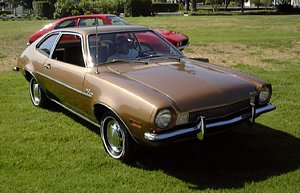 |
Subject: Ford Pinto
Photographer/Source: "Morven" (Wikimedia Commons) Location/Event: So Cal Galaxies All-Ford Show 
License: GNU Free Documentation License View photo of Ford Pinto - 67KB |
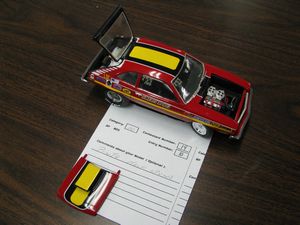 |
Subject: Kendig/Dyno Don Pro Stock 1976 Ford Pinto Scale Model
Photographer: Bill Crittenden Event: 2009 Cedarville Model Car Contest and Swap Meet 
View photo of 1976 Ford Pinto Kendig/Dyno Don Pro Stock Drag Race Model Car - 3,734KB |
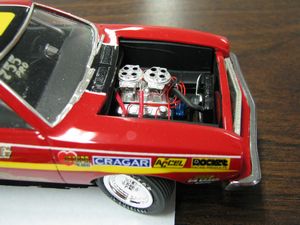 |
Subject: Kendig/Dyno Don Pro Stock 1976 Ford Pinto Scale Model
Photographer: Bill Crittenden Event: 2009 Cedarville Model Car Contest and Swap Meet 
View photo of 1976 Ford Pinto Kendig/Dyno Don Pro Stock Drag Race Model Car - 3,449KB |
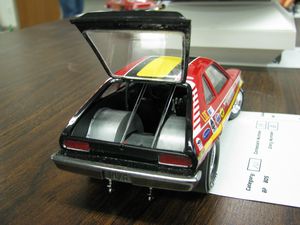 |
Subject: Kendig/Dyno Don Pro Stock 1976 Ford Pinto Scale Model
Photographer: Bill Crittenden Event: 2009 Cedarville Model Car Contest and Swap Meet 
View photo of 1976 Ford Pinto Kendig/Dyno Don Pro Stock Drag Race Model Car - 3,328KB |
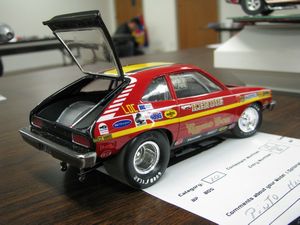 |
Subject: Kendig/Dyno Don Pro Stock 1976 Ford Pinto Scale Model
Photographer: Bill Crittenden Event: 2009 Cedarville Model Car Contest and Swap Meet 
View photo of 1976 Ford Pinto Kendig/Dyno Don Pro Stock Drag Race Model Car - 3,403KB |
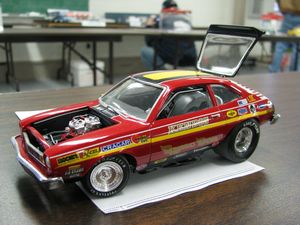 |
Subject: Kendig/Dyno Don Pro Stock 1976 Ford Pinto Scale Model
Photographer: Bill Crittenden Event: 2009 Cedarville Model Car Contest and Swap Meet 
View photo of 1976 Ford Pinto Kendig/Dyno Don Pro Stock Drag Race Model Car - 3,809KB |
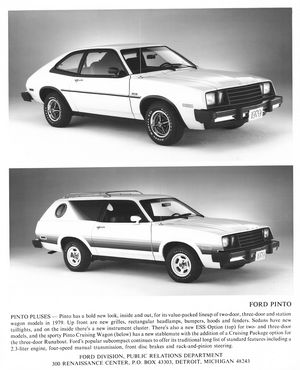 |
Subject: 1979 Ford Pinto
Source: Ford Public Relations Photo Caption: PINTO PLUSES - Pinto has a bold new look, inside and out, for its value-packed lineup of two-door, three-door and station wagon models in 1979. Up front are new grilles, rectangular headlamps, bumpers, hoods and fenders. Sedans have new taillights, and on the inside there's a new instrument cluster. There's also a new ESS Option (top) for two- and three-door models, and the sporty Pinto Cruising Wagon (below) has a new stablemate with the addition of a Cruising Package option for the three-door Runabout. Ford's popular subcompact continues to offer its traditional long list of standard features including a 2.3-liter engine, four-speed manual transmission, front disc brakes and rack-and-pinion steering. View photo of 1979 Ford Pinto - 2.8MB |
